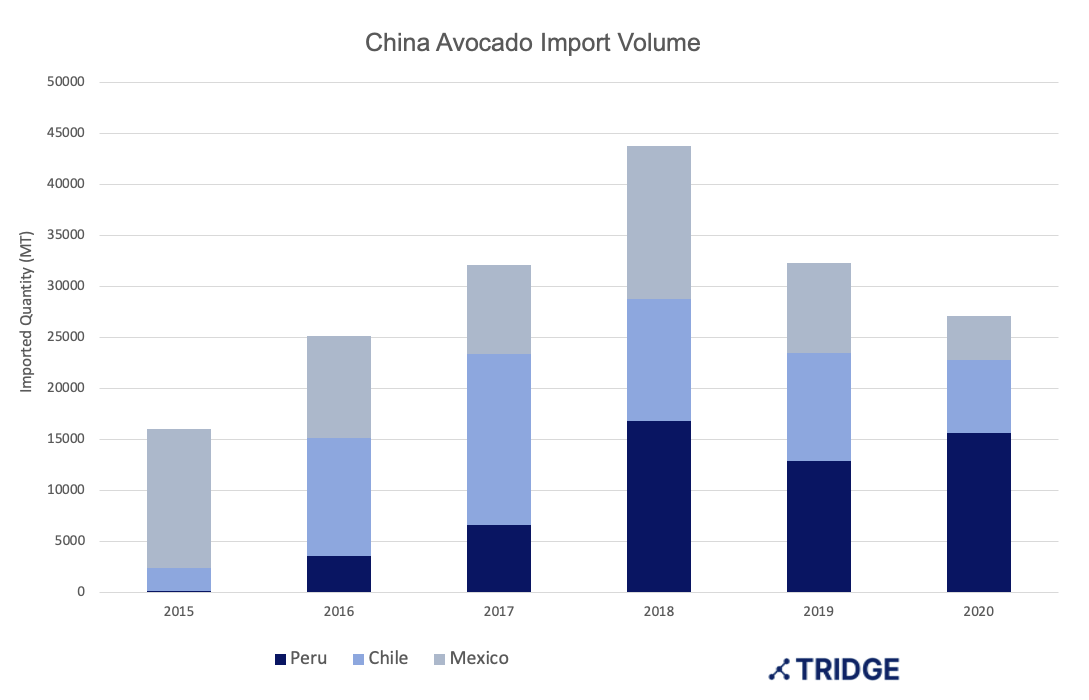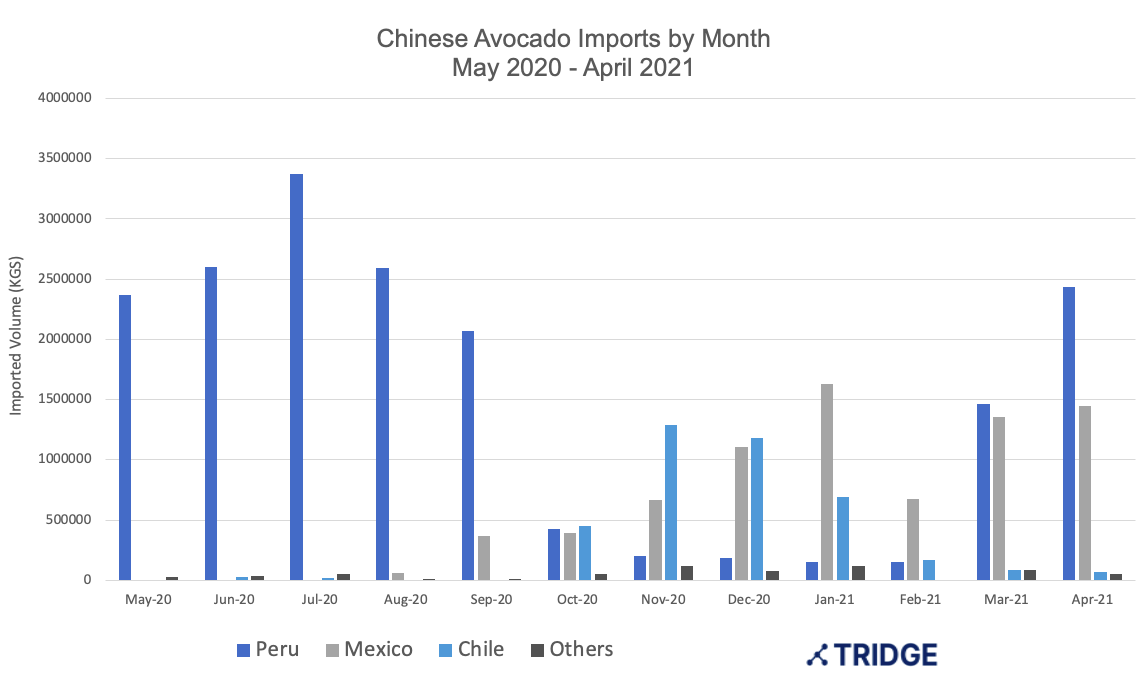Ready, Steady, Go! The Chinese Avocado Market Race
Historical Overview of the Race
Avocados are one of the fastest-growing fruits in China. From 2014 to 2018, avocado imports went from 4,000 tons to 43,800 tons having a 63% yearly growth rate. Mexico was the first country to receive permission for avocado export to China, and since 2013 it has started sending shipments regularly. In 2014, Mexico accounted for 97% of the total avocado imported by China. From 2014 to 2015, Peru and Chile successively obtained the access certificate to export avocados to China and enjoyed the preferential treatment of zero tariffs. Since then, Chile took over the role of the lead supplier until 2018, when Peru took the lead.
Affected by factors such as the pandemic and the China-US trade war, the country’s avocado imports declined in 2020, falling to 27,000 tons. Nevertheless, Peru remained the leading supplier last year with 52.2% of the import share while Chile and Mexico remained behind at 30.3% and 15.5%, respectively. Peru was also the only country that increased its exports to China in 2020 by 4% from the previous year, while the rest of the suppliers decreased their exports.

Source: ITC Trade Map, Tridge
The Chinese avocado import market is expected to go back to its accelerated growth. Despite logistics issues in the main entry ports and sea container shortages, a 33.3% increase in imported volume was recorded in the first eight months of the year. In addition, both of the countries that have almost ended their export season, Mexico and Peru, have registered increases in their shipments.
Mexico: Record High Export Volume this year with some quality concerns
The retail season of Mexican avocados is almost over. According to recent data from Chinese Customs, avocado exports from Mexico to China have reached a record high between January and August this year. From the 24,670 tons that China bought during this period, 5,539 tons were imported from Mexico, which accounted for 22.5% of the total imports. With the increase, China had a 207% increase year-on-year for avocado imports from Mexico. Over the same period last year, the volume imported from Mexico was only 9.5% of the total import volume.
In numbers, Mexico had a historical year for avocado shipments to China mainly due to its availability in the market since January. However, the product quality of Mexican avocados dropped towards the end of the season with concerns about the humidity and moisture of the fruit. With the shipping problems that were faced throughout the year, Mexican avocados weren’t able to maintain their quality by the end of the season.
Zeling Xue, Trige’s Engagement Manager in China, has reported that Chinese buyers prefer Chilean avocados from November to March and Peruvian avocados from March to October. However, buyers currently do not prefer Mexican avocados due to the frequent occurrence of quality problems. General quality problems found with Mexican avocados are fast darkening and rotting avocados due to extended shipping distances that don't cope well with the humidity of the Mexican fruit.
Peru: Will Steady Grow be Enough to Remain Leaders?
According to the Peruvian Hass Avocado Producers Association (ProHass), for the nearly over MY 2020/21 season, Peruvian avocados will reach 470,000 tonnes in exports, an increase of 30% over the previous season. For the Chinese market, the association estimates to close the market with a 7% increase in volume from the prior year, at around 16,000 tons. Although Peru had a record-breaking year with a 30% increase from the previous year, exports to China have grown in a more conservative way. For Peru, China is one of the most promising markets to emerge in recent years. Last season it paid one of the highest prices for Peruvian avocados, which averaged USD 2.10 per KG, 6% more than the overall average price.
Peru started the year in January by shipping 1,970 tonnes of avocados, which was a 137% increase from the same month the previous year. Peru normally enters the Chinese market when Chilean supply is low. However, this year, the Chilean export campaign was brought to an early end due to a sharp fall in Chilean production. As a result, Peruvian avocados started their campaign earlier, creating a bigger export window for them.
The biggest problem this season for Peruvian avocados was the uncertainty of shipping periods. The unexpected delays in shipping ports have affected prices this season as it has created sudden arrivals of shipping containers at the same time. Chinese importers needed to wait for days until their products arrived, causing severe problems in storage spaces with distributors and wholesalers.

Source: ITC Trade Map, Tridge
Chile: Solid Production will Try to Recover the Market
This year, the Chilean avocado production volume is large, unlike last year when heavy rainfall caused a sharp fall. Backed by solid production volume, for MY 2021/22, Chile will try to remain Europe’s second-largest provider of fresh avocados and has set their eyes on the Chinese market to regain the market they were once the leader of. In 2020, Chile exported 7,000 tons of avocados to China, 33.5% less than the previous year as a direct result of the decrease in Chinese imports, while Peru increased exports by 4%. In 2016 and 2017, Chile was the leading supplier to China until Peru gained access to the market and, by 2018, relegated Chile to second place.
According to Jorge Neira, Tridge representative in Chile, avocado's export season has started slow this year due to prioritizing the local market first. However, it is expected that volumes will begin to increase to Asian markets from the beginning of October. Chilean avocados will arrive around the same time as Peruvian avocados disappear from the market. The price will likely start high this year as the temporary supply shortage will probably push the price of Chilean avocados up, and then the price is expected to decrease slightly.
For the Chilean season to be successful in China this year, it will depend on product availability and quality in order to maintain the price as high as possible from the beginning of the season. Another critical factor will be the container shortage crisis and the shipping times that the South American - Asian routes will allow.
Sources:
- Fruitnet. "Positive outlook for Peruvian avocados in China."
- Fresh Plaza. "Market analysis of imported avocados in the Chinese market."
- Fresh Plaza. "207% increase in exports of Mexican avocados to China in 2021."
- Tridge Local Insight. "Mexico avocado not preferred by Chinese buyers due to quality issues."
- Tridge Analysis. "Avocado Production in Chile to Strongly Recover for MY 2021/22."
- Tridge Analysis. "Record-Breaking Year for Peruvian Avocados."






